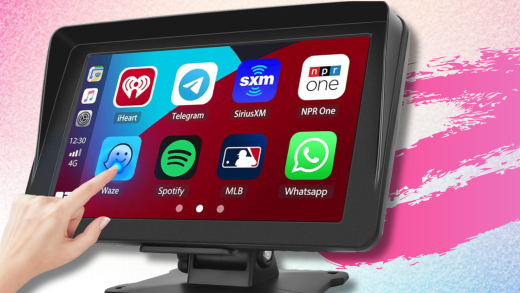An elaborate desktop setup that can transition to portable demands a capable desktop dock. Kensington’s LD4650P is one such dock, with some impressive locking features thrown in. But its bells and whistles fail to justify the sky-high price for most.
Using the LD4650P with its single USB-C connection gives your Windows laptop access to two DisplayPort screens, four USB 3.0 ports, Ethernet data, and a standard headphone jack. It all works as advertised, with the added benefit of locking down your laptop to a heavy base. You can then lock the base to a desk or table with the included chain. But at $250, you need to use every single feature—and be okay with some major ergonomic and functional drawbacks—to consider this dock.
Lock It Down
The LD4650P is odd-looking, with a heavy metal base that slips up underneath the hinge of a laptop. Two “wings” on either side clamp down on the hinge, to lock the dock in place. How do you release the wings from the laptop when you’re done working? The LED on the right side gives you a clue. When you pass the included “key” (a plastic fob with what I assume is an RFID chip inside) over the right side, it releases the wings. The green LED flashes to blue, and both sides click outward thanks to a small internal motor.

It’s remarkably secure with the wings in place, and the dock secured with a Kensington laptop lock. But there are some serious drawbacks to this design. Most obviously, it doesn’t work with anything like a tablet. It’s impossible to secure a Surface Pro or my HP Chromebook X2 in this dock. That doesn’t mean the electronic components cease to function. But anything other than a standard laptop—and even then, a fairly thin one, with no protruding battery—won’t be able to use this security feature.

The dock’s locking mechanism also won’t work if the power supply isn’t in place, which isn’t an issue for a conventional lock. That’s probably not a problem for most people. After all, why have a USB-C dock if you’re not going to keep it working? It does, however, make this gadget unsuitable for more extensive deployments that aren’t using its full capacities at every engagement.
Based on your particular scenario, the unique RFID key might be an advantage or a disadvantage over the more general Kensington lock key.
Using the Dock
Using the dock was a more pleasant, flexible experience. The placement allows you to easily connect up to two monitors (plus the laptop’s screen), as well as any USB-based accessories you might want. I was disappointed to find only two video-out options, and no choices for the much more common HDMI, with resolution limited to 1920 x 1200 maximum. The dock could handle my 2560 x 1440 main monitor, but only when a secondary screen wasn’t connected at the same time.

I was also disappointed the dock only supports USB-A connections, even though they’re high-speed 3.1 spec. This meant I couldn’t plug in any of my USB-C devices directly to the dock—I had to use a secondary port on the laptop.
The USB-C PD connection on the dock works flawlessly and carries video and data without any major issues or errors. (It didn’t work on my HP Chromebook, but that’s not the only problem I’ve had with that machine—it performed exactly as expected on Windows.)
Read the remaining 8 paragraphs
Source : Kensington’s LD4650P Is an Okay Dock and Lock, but an Expensive Combo















